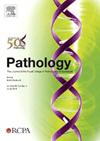Judicious use of precise fluorescence in situ hybridisation panels guided by population prevalence may assist pragmatic detection of clinically targetable Philadelphia chromosome-like acute lymphoblastic leukaemia fusions: a systematic review
IF 3.6
3区 医学
Q1 PATHOLOGY
引用次数: 0
Abstract
Diagnosis of Philadelphia chromosome-like acute lymphoblastic leukaemia (Ph-like ALL) in the real-world remains challenging because of definitional complexities, the diverse diagnostic techniques available and the cost, expertise and time involved. We summarise evidence for diagnosis of clinically important Ph-like ALL related genomic lesions using fluorescence in situ hybridisation (FISH) targeting only clinically important and actionable lesions, an accessible and cost-effective diagnostic technique.
Electronic databases were interrogated using broad MeSH terms for articles reporting a detailed FISH strategy for diagnosis of Ph-like ALL published since 2014, yielding 653 full text articles and abstracts. We searched the National Library of Medicine Databases including PubMed, Medline, Embase, Cochrane and relevant abstracts. We included studies with a primary aim of determining the utility of FISH for Ph-like ALL diagnosis and studies with broader aims demonstrating Ph-like ALL diagnostic algorithms which partially involved FISH.
Nineteen studies met inclusion criteria. Evidence for FISH to detect CRLF2 rearrangements in Ph-like ALL is strongly established and evidence for FISH to detect non-CRLF2 lesions is evolving rapidly. We documented 1620 cases of non-CRLF2 Ph-like lesions diagnosed by FISH. Confirmatory side-by-side methods were applied in six studies (246 samples), four of which demonstrated 100% concordance of FISH results with alternative methods, while two studies demonstrated over 70% sensitivity and specificity. Additional studies demonstrated wide utilisation of FISH in Ph-like ALL classification across diverse geographies and ethnicities, with contrasting prevalence, implicating a need for targeted FISH strategies.
In real-world cohorts, it may be clinically useful to prioritise limited early FISH in B-cell ALL (B-ALL) diagnostic algorithms to identify Ph-like abnormalities that respond to locally available kinase inhibitors to promote and prioritise broad access to effective targeted treatment. Additional studies are required to provide adequately powered validations and verifications of targeted Ph-like FISH panels to confirm sensitivity and specificity against side-by-side gold standard methods, and to define optimal local approaches.
以人群流行率为指导,明智地使用精确的荧光原位杂交面板,可帮助实用地检测临床上可靶向的费城染色体样急性淋巴细胞白血病融合:系统综述
在现实世界中,费城染色体样急性淋巴细胞白血病(Ph-like ALL)的诊断仍然具有挑战性,因为定义复杂、诊断技术多样,而且涉及成本、专业知识和时间。我们总结了利用荧光杂交(FISH)技术诊断临床上重要的Ph-like ALL相关基因组病变的证据,该技术只针对临床上重要且可操作的病变,是一种方便且经济有效的诊断技术。
本文章由计算机程序翻译,如有差异,请以英文原文为准。
求助全文
约1分钟内获得全文
求助全文
来源期刊

Pathology
医学-病理学
CiteScore
6.50
自引率
2.20%
发文量
459
审稿时长
54 days
期刊介绍:
Published by Elsevier from 2016
Pathology is the official journal of the Royal College of Pathologists of Australasia (RCPA). It is committed to publishing peer-reviewed, original articles related to the science of pathology in its broadest sense, including anatomical pathology, chemical pathology and biochemistry, cytopathology, experimental pathology, forensic pathology and morbid anatomy, genetics, haematology, immunology and immunopathology, microbiology and molecular pathology.
 求助内容:
求助内容: 应助结果提醒方式:
应助结果提醒方式:


